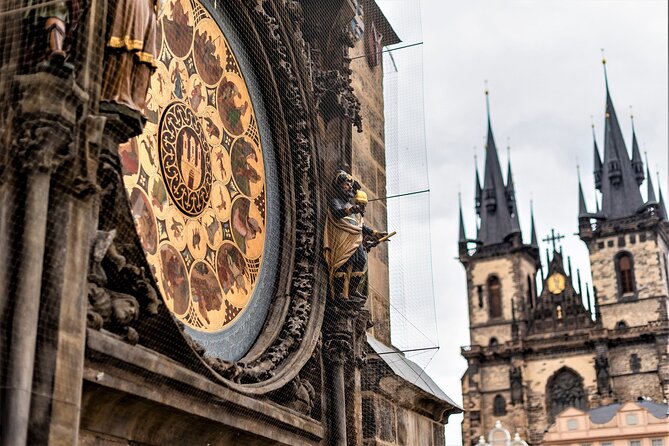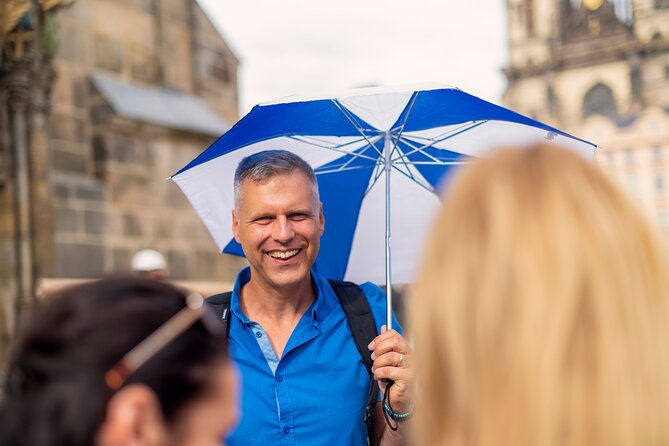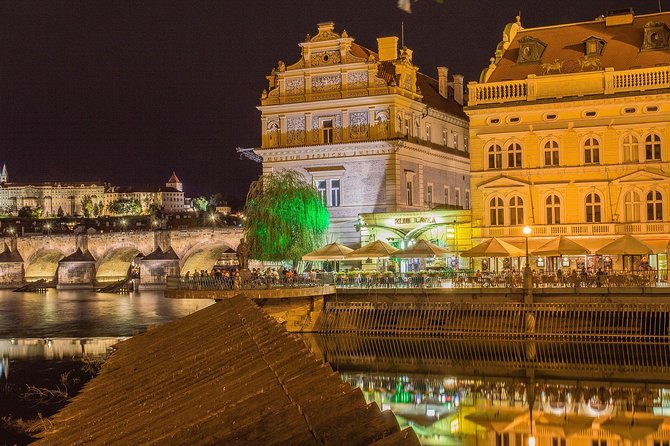The Prague Astronomical Clock, or Prague Orloj (Czech: Pražský orloj [praʃskiː orloj]), is a medieval astronomical clock located in Prague, the capital of the Czech Republic. The clock was first installed in 1410, making it the third-oldest astronomical clock in the world and the oldest clock still operating. The Orloj is mounted on the southern wall of Old Town Hall in the Old Town Square. The clock mechanism has three main components — the astronomical dial, representing the position of the Sun and Moon in the sky and displaying various astronomical details; statues of various Catholic saints stand on either side of the clock; "The Walk of the Apostles", a clockwork hourly show of figures of the Apostles and other moving sculptures, notably a figure of a skeleton, representing Death, striking the time; and a calendar dial with medallions representing the months. According to local legend, the city will suffer if the clock is neglected and its good operation is placed in jeopardy; a ghost, mounted on the clock, was supposed to nod its head in confirmation. According to the legend, the only hope was represented by a boy born on New Year's night. The oldest part of the Orloj, the mechanical clock and astronomical dial, dates from 1410 when it was made by clockmaker Mikuláš of Kadaň and Jan Šindel, then later a professor of mathematics and astronomy at Charles University. The first recorded mention of the clock was on 9 October 1410. Later, presumably around 1490, the calendar dial was added and the clock facade was decorated with gothic sculptures. Formerly, it was believed that the Orloj was constructed in 1490 by clockmaster Jan Růže (also called Hanuš); this is now known to be a historical mistake. A legend, recounted by Alois Jirásek, has it that the clockmaker Hanuš was blinded on the order of the Prague Councillors so that he could not repeat his work; in turn, he disabled the clock, and no one was able to repair it for the next hundred years. In 1552 it was repaired by Jan Taborský (ca 1500–1572), master clockmaker of Klokotská Hora, who also wrote a report of the clock where he mentioned Hanuš as the maker of this clock. This mistake, corrected by Zdeněk Horský, was due to an incorrect interpretation of records from the period. The mistaken assumption that Hanuš was the maker is probably connected with his reconstruction of the Old Town Hall in the years 1470–1473. The clock stopped working many times in the centuries after 1552, and was repaired many times. The legend was used as the main plot in the animated movie Goat story — The Old Prague Legends. In 1629 or 1659 wooden statues were added, and figures of the Apostles were added after a major repair in 1787–1791. During the next major repair in the years 1865–1866 the golden figure of a crowing rooster was added. The Orloj suffered heavy damage on May 7 and especially May 8, 1945, during the Prague uprising, when the Nazis fired on the south-west side of the Old Town Square from several armoured vehicles in an unsuccessful attempt to destroy one of the centers of the uprising. The hall and nearby buildings burned, along with the wooden sculptures on the clock and the calendar dial face made by Josef Mánes. After significant effort, the machinery was repaired, the wooden Apostles restored by Vojtěch Sucharda, and the Orloj started working again in 1948. The Orloj was renovated in autumn 2005, when the statues and the lower calendar ring were restored. The wooden statues were covered with a net to keep pigeons away. The last renovation of the astronomical clock was carried out from January to September 2018, following a reconstruction of the Old Town Tower. During the renovation, an electric clock mechanism that had been in operation since 1948 was replaced by an original mechanism from the 1860s.

Prague Astronomical Clock (Prague Orloj) Tours and Tickets
🎧 Available audio guides (14)
The Prague Astronomical Clock, or Prague Orloj (Czech: Pražský orloj [praʃskiː orloj]), is a medieval astronomical clock located in Prague, the capital of the Czech Republic. The clock was first installed in 1410, making it the third-oldest astronomical clock in the world and the oldest clock still operating. The Orloj is mounted on the southern wall of Old Town Hall in the Old Town Square. The clock mechanism has three main components — the astronomical dial, representing the position of the Sun and Moon in the sky and displaying various astronomical details; statues of various Catholic saints stand on either side of the clock; "The Walk of the Apostles", a clockwork hourly show of figures of the Apostles and other moving sculptures, notably a figure of a skeleton, representing Death, striking the time; and a calendar dial with medallions representing the months. According to local legend, the city will suffer if the clock is neglected and its good operation is placed in jeopardy; a ghost, mounted on the clock, was supposed to nod its head in confirmation. According to the legend, the only hope was represented by a boy born on New Year's night. The oldest part of the Orloj, the mechanical clock and astronomical dial, dates from 1410 when it was made by clockmaker Mikuláš of Kadaň and Jan Šindel, then later a professor of mathematics and astronomy at Charles University. The first recorded mention of the clock was on 9 October 1410. Later, presumably around 1490, the calendar dial was added and the clock facade was decorated with gothic sculptures. Formerly, it was believed that the Orloj was constructed in 1490 by clockmaster Jan Růže (also called Hanuš); this is now known to be a historical mistake. A legend, recounted by Alois Jirásek, has it that the clockmaker Hanuš was blinded on the order of the Prague Councillors so that he could not repeat his work; in turn, he disabled the clock, and no one was able to repair it for the next hundred years. In 1552 it was repaired by Jan Taborský (ca 1500–1572), master clockmaker of Klokotská Hora, who also wrote a report of the clock where he mentioned Hanuš as the maker of this clock. This mistake, corrected by Zdeněk Horský, was due to an incorrect interpretation of records from the period. The mistaken assumption that Hanuš was the maker is probably connected with his reconstruction of the Old Town Hall in the years 1470–1473. The clock stopped working many times in the centuries after 1552, and was repaired many times. The legend was used as the main plot in the animated movie Goat story — The Old Prague Legends. In 1629 or 1659 wooden statues were added, and figures of the Apostles were added after a major repair in 1787–1791. During the next major repair in the years 1865–1866 the golden figure of a crowing rooster was added. The Orloj suffered heavy damage on May 7 and especially May 8, 1945, during the Prague uprising, when the Nazis fired on the south-west side of the Old Town Square from several armoured vehicles in an unsuccessful attempt to destroy one of the centers of the uprising. The hall and nearby buildings burned, along with the wooden sculptures on the clock and the calendar dial face made by Josef Mánes. After significant effort, the machinery was repaired, the wooden Apostles restored by Vojtěch Sucharda, and the Orloj started working again in 1948. The Orloj was renovated in autumn 2005, when the statues and the lower calendar ring were restored. The wooden statues were covered with a net to keep pigeons away. The last renovation of the astronomical clock was carried out from January to September 2018, following a reconstruction of the Old Town Tower. During the renovation, an electric clock mechanism that had been in operation since 1948 was replaced by an original mechanism from the 1860s.
Overview
More Info
- The clock performance happens every hour from 9am–11pm.
- Look for the skeleton turning over his hourglass to signify the human life span.
- The square gets very busy at performance times, so keep an eye on your belongings.
More Adventures for You
0$
0$
3000$

Price From
$24.42 USD
Get easily and quickly admission ticket to the Astronomical Clock Tower Enjoy a 20 minutes introductory overview of the Astronomical Clock in the English language and then explore it at your own pace See the famous 600-year-old Astronomical Clock Tower Take in spectacular views of the city from the Gothic-style Clock Tower Explore the Old Town and Astronomical Clock with an Online AUDIOGUIDE (if option selected)_en-US
Learn More
Price From
$28.86 USD
See Old Town Square, Charles Bridge, Prague Castle, and more on this 3-hour tour Enjoy learning about the history and architecture of Prague by hearing its legends and stories Take in the views from Prague Castle and soak up the city's eclectic mix of past and present_en-US
Learn More
Price From
$18.87 USD
This 1,5 hour walking tour gives you the Prague landmarks and the atmosphere that made Prague one of Europe’s top destinations. Explore the oldest and most important sights of the former Jewish ghetto and the Old Town of Prague. Learn about the ancient history of Jewish people in the Czech lands and see their unique monuments such as the oldest preserved synagogue in the whole of Europe! Descent into the maze of cobbled streets of the Old Town, admire the stunning architecture of the Old Town Square and its prodigious Astronomical Clock - all this with a knowledgeable local guide!_en-US
Learn More
Price From
$133.82 USD
This is a one-of.a-kind project in Prague! Rent your local guide for a day and get all the information (including tips-and-tricks) you need and want to have!_en-US
Learn More
Price From
$104.22 USD
Forget the party crowds—this experience reveals Prague’s intimate, storied side after dark. As twilight falls over the spires and cobbled lanes, your host will guide you through a relaxed and authentic evening crafted around your preferences. Whether it’s soaking in skyline views, swapping stories over drinks, or uncovering legends in forgotten alleys, this experience offers a deeper connection to the city. Within 24 hours of booking, we’ll reach out to understand your interests. Based on your profile, we’ll match you with a like-minded host and work with you to design the perfect itinerary—one that adapts as you go and invites you to explore Prague like a local._en-US
Learn More

For Individuals with Hearing Loss
- Video Guide
Access for Seniors
- Recommended time for visit 1 hour
- Recommended time for visit 2 hours
- Physical difficulty level - 3
Accessibility for wheels
- Special Parking
- Access with Portable Ramp
- Can have severe slope, cobblestones, and/or gravel
- Bathroom: Too narrow for wheelchair
- Wide doors >= 75 cm and < 90 cm
Access for Visually Impaired
- Audio Guide
- Place has Special Guide Service
- Service animals permitted
As you stand in the heart of Prague’s Old Town Square, you are surrounded by the sounds of bustling crowds, the scent of freshly baked pastries from nearby cafes, and the sight of centuries-old architecture that whispers tales of times long past. But amidst all this, there is a focal point that draws your attention - the Prague Astronomical Clock, also known as the Prague Orloj.
Approaching the clock, you feel a sense of anticipation tinged with wonder. The intricate details of the clock’s face come into view - the golden hands moving gracefully, the intricate carvings and symbols that adorn its surface. Each element seems to hold a story, a connection to the history and culture of this enchanting city.
As the hour approaches, a hush falls over the square. The gentle chimes of the clock resonate through the air, marking the passage of time in a way that feels both ancient and timeless. And then, as the clock strikes, a symphony of movement begins.
The Twelve Apostles make their silent procession, each figure emerging to bestow a blessing upon the city. You can almost envision their robes billowing in the wind, their faces serene and wise. It’s a moment frozen in time, a dance of faith and devotion that speaks to something deep within you.
But it’s not just the figures that captivate you - it’s the intricate dance of the celestial bodies above. The sun and moon begin their eternal journey across the sky, casting shifting shadows upon the face of the clock. It’s a reminder of the interconnectedness of all things, a glimpse into the vastness of the universe.
And as the spectacle comes to an end, you are left with a sense of reverence and awe. The Prague Astronomical Clock is not just a timepiece - it’s a window into the soul of Prague, a reflection of its history, its culture, its spirit. It’s a reminder that even in a world that seems ever-changing, there are constants that endure.
So as you linger in the shadow of the clock, you can’t help but feel a sense of gratitude for this moment, this experience. The emotions stirred within you are a testament to the power of beauty, of art, of history. And as you turn to leave, the memory of the Prague Orloj lingers on, a spark of magic that will stay with you long after you have left its presence.
The Prague Astronomical Clock (Prague Orloj) does not currently offer audio descriptive guides or sensory-friendly hours. However, visitors with accessibility needs are advised to contact the attraction directly for the most up-to-date information on available services and accommodations.
The Prague Astronomical Clock, also known as Prague Orloj, is not just a tourist attraction in the heart of the Old Town Square, it is a cultural symbol that holds a special place in the hearts of the locals. Its intricate design, dating back to the 15th century, continues to mesmerize both tourists and residents alike.
Local artist, Martina Nováková, finds inspiration in the Prague Astronomical Clock. She says, "The Orloj is not just a clock to me, it is a work of art that tells the story of Prague’s rich history. The details in the design, from the zodiac signs to the figures of the apostles, are truly remarkable and a source of endless inspiration for my own artistic creations."
For many locals, the chimes of the Prague Orloj mark the passing of time and connect them to the city’s past. Petr Novotný, a resident of Prague, shares his experience, "I remember as a child standing in awe in front of the Astronomical Clock, watching the figures dance and the bells chime. Even now, whenever I pass by, I can’t help but stop and admire its beauty. It’s a reminder of the enduring history and culture of this city."
The Prague Astronomical Clock is not just a piece of history or a tourist attraction, it is a living symbol of Prague’s heritage that continues to captivate both locals and visitors. As Martina Nováková beautifully puts it, "The Orloj is a testament to the craftsmanship and artistry of those who came before us, a timeless treasure that will always hold a special place in the heart of Prague."
Directions and Transportation:
1. By Public Transport:
- Trams: Take tram numbers 17, 18, or 53 to the stop "Staroměstská".
- Metro: Take the metro to Staroměstská station (Line A) and walk for a few minutes to reach the Astronomical Clock.
2. By Taxi or Ride-sharing:
- Taxis and ride-sharing services are widely available in Prague. You can easily book a cab or use apps like Uber or Bolt to reach the Astronomical Clock.
3. By Walking:
- The Astronomical Clock is located in the Old Town Square, which is easily accessible by walking if you are in the city center.
4. Accessibility Information:
- The area around the Astronomical Clock may have cobblestones and uneven surfaces, which could pose challenges for visitors with mobility issues. It’s recommended to check with local authorities for updated accessibility information.
Ticket Booking and Discounts:
- Tickets to view the Astronomical Clock are not required as it is a public exhibit. However, if you wish to access the Tower, there may be a fee. Check the official website or inquire on-site for the latest ticket prices and information on guided tours.
- Discounts: Some discounts may be available for students, seniors, or groups. Inquire at the ticket office or check the official website for any available discounts.
Local Amenities:
1. Parking:
- Limited parking spaces are available near the Old Town Square. Consider using public transportation or parking in designated lots nearby.
2. Restrooms:
- Public restrooms are located in the vicinity of the Astronomical Clock. You may need to pay a small fee to use them.
3. Dining Options:
- There are numerous cafes, restaurants, and food stalls around the Old Town Square catering to different dietary needs. Vegetarian, vegan, gluten-free, and traditional Czech food options are available. Prices may vary, so check menus before dining.




